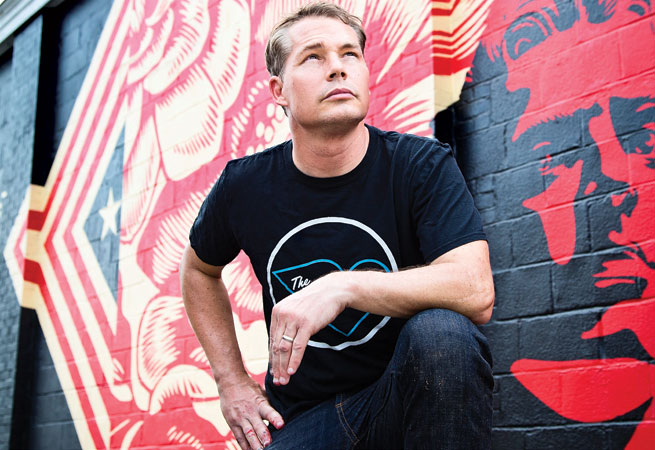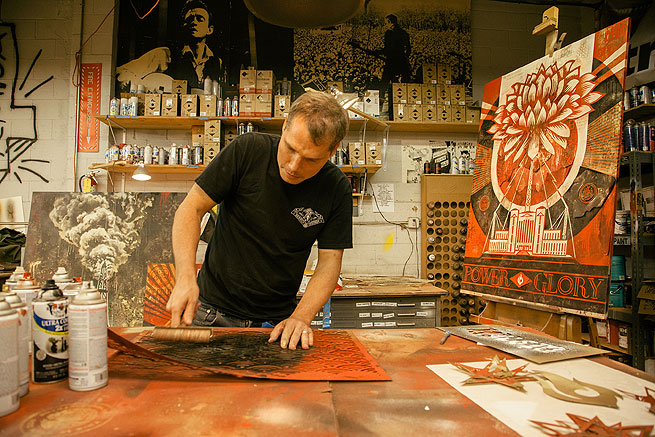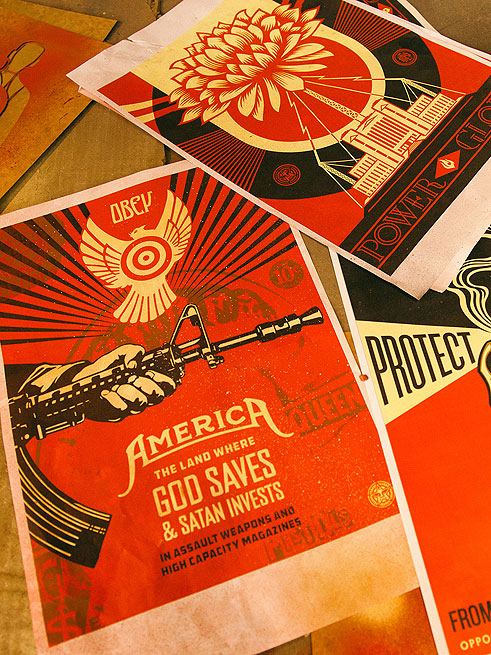Charleston City Paper (May 2014)
From The Giant: The Definitive Obey Giant Site
From Charleston City Paper (May 2014):
Shepard Fairey explores empire and the American dream this Spoleto season by Elizabeth Pandolfi
Shepard Fairey is many things — street artist, fine artist, commercial success, South Carolina native, skater punk — but subtle he is not.
Take his mixed media piece "Learn to Obey," in which a young adult dressed in Boy Scout-style garb salutes, à la Hitler youth, an American flag with a dollar sign in place of the 50 stars. Or "Paint It Black (Brush)," where the words "I see the green earth and I want to paint it black" rise above a hand painting a thick black circle around the globe. The paint comes out of a can labeled "Oil-Based Policy."
If you want to see Fairey at his most in-your-face, just look at his 2007 piece "Rise Above Cop," which shows a policeman wielding a baton and pointing at the viewer. Across the top and bottom stretch the words "I'm gonna kick your ass and get away with it!" Content-wise, these are not pieces that you'd expect to adorn the clean white walls of a high-end art gallery or museum (quality- and skill-wise, however, absolutely).
And yet in a fine art world where subtlety and even obscurity are often heralded as two of the noblest virtues, Fairey's work has become respected and collected. He's that rare breed of artist who is equally sincere whether he's plastering a brick wall with the looming face of Andre the Giant or creating a new body of work for a gallery exhibition — which he has done for the Halsey Institute of Contemporary Art's 30th anniversary show, The Insistent Image: Recurring Motifs in the Art of Shepard Fairey and Jasper Johns.
"He's kind of a shapeshifter," says the Halsey's director and Insistent Image curator Mark Sloan. "He can fill any vessel that's there for him to fill, commercial, street art, fine art."
Maybe that's because of the unique way Fairey's art career began. You're probably familiar with the image that started it all: the black-and-white face of Andre the Giant.
Shepard Fairey Has a Posse
We in Charleston like to remind ourselves that Fairey is a native son, born and raised in the Holy City. But although he spent his childhood here, his formative years as an artist were spent in the Northeast — at 18, he left the Lowcountry for the Rhode Island School of Design (RISD).
It was there, in 1989, that he came up with the Andre the Giant Has a Posse sticker campaign. Fairey created a stencil of the wrestler and, along with a few of his RISD friends, put it on stickers that they clandestinely placed around Providence, R.I. The stickers made their way to cities up and down the East Coast, then across the country, then worldwide. And of course, this was in the days before the internet, when people actually had to see something in real life in order to spread it elsewhere. "That went viral before we knew what viral meant," Sloan says.
In the early '90s, after threat of a lawsuit from the company holding the trademark to the name Andre the Giant, Fairey changed the image to a more graphic representation of Andre the Giant's face, adding the word "Obey."
Although the "Obey" image has been seen by millions, that's not the thing that made Fairey famous. In fact, most of those millions probably didn't know or really care who was behind the stickers, since the cool thing about them was that they'd just appear suddenly in random places.
The thing that did make him famous was, of course, his "Hope" poster featuring a portrait of then-Sen. Barack Obama during the 2008 presidential campaign.
But in the intervening 20 years between RISD and the year Obama became president, Fairey hasn't been sitting on his ass, creatively stifled. He's been hitting the streets hard, putting up his trademark anti-establishment, anti-authoritarian prints and posters for no other reason than because he loved doing it. "I never expected to have an art career — that wasn't my ambition," Fairey says. "I studied illustration and did a lot of printmaking and graphic design. I didn't study painting because I didn't think I was a good enough painter to have a fine art career." He started doing street art "with no expectations," he says, and a few galleries had tracked him down when clients of theirs walked in after seeing something of Fairey's on a street corner or building, and asked where they could find the artist's work. By the early 2000s, the street artist was showing his pieces all over the world.
And then came 2008. Like Andre the Giant, the popularity of the "Hope" poster was a happy accident. Fairey believed in Obama and what he could bring to the country, so without any connection to or endorsement by the Democratic Party, he created the poster and distributed it. "It was different in that it was a sincere endorsement, rather than a critique like I usually do," Fairey says. If you had any interest in the Obama campaign that year, you remember how it blew up — suddenly Shepard Fairey was a well-known name outside the art community, and with people who never in their lives had set foot in an art gallery or contemporary art museum.
Such sudden recognition could turn anyone's head, but Fairey says it was pretty easy for him to keep his. "The Obama thing was very surprising, but you know, I was 38 years old when that happened. I had 10 years of living in poverty under my belt. I think when people get a big ego it's usually because they have success early on, without understanding the complexity of the variables that go into it and how arbitrary it can be."
Just a year after his pop-political success, in 2009, the Institute of Contemporary Art Boston hosted the first museum survey of Fairey's work, Supply and Demand: 20-Year Retrospective. His work now hangs in New York's Museum of Modern Art (MoMA), the Victoria and Albert Museum in London, the Los Angeles County Museum of Art, and the National Portrait Gallery in Washington, D.C., among others.
Enjoy Power and Glory While They Last
One of the things that makes Fairey's art so striking in its original home on the streets is how he stylistically borrows from old propaganda posters. That's especially true of the body of work he'll be showing at the Halsey, the Power and Glory series, a collection of prints and mixed-media works exploring concepts like empire, the destruction of the environment, and most importantly, the American Dream. Almost all of it has been created specifically for this show. "The show's an exploration of, a celebration of, and critique of these symbols of Americana and ideas of Americana, whether it's capitalism, politics, or the environment," Fairey says. "On the one hand I think that there's a little bit of an American sense of entitlement, and that's the dark side of the American Dream. The bright side is that — hypothetically — hard work will be rewarded. But I think the dynamics of our political system, the way campaign finance works, and the leverage that big business has pushed the American Dream further out of reach for a lot of people."
Pieces in his Power and Glory series address everything from climate change (see "Paradise Turns," a 1950s-style travel poster of a couple on the beach and oil towers in the background, underneath the words "Enjoy paradise until the tide turns") to financial corruption ("Scale Tipping Services," featuring an un-blindfolded Lady Justice weighing a skull against a bag of money). The ideas are clear — often they're literally spelled out for the viewer — but the thing that has kept art insiders interested in his work, besides the delicacy and beauty of his pieces, is that underneath those up-front messages lie oceans of nuance.
In "God Saves and Satan Invests" a hand holding an automatic firearm is in the foreground, with an American eagle with a target across its chest flying across the background. It's a stab at the NRA, certainly, but it could also speak to the financial collapse or to the hijacking of capitalism by big business. "Capitalism needs a referee and that referee needs to be the government. And if the government is a partner, not a referee, that's bad for the average person. I want democracy to work right," Fairey says. "There are a lot of incredibly great things about America, but rather than being a nationalist and just assuming that everything that's happening in the country is great because I'm a loyal American, I actually think patriotism is about critiquing things when they deviate from the original conceptions of justice and pursuit of happiness and personal liberty."
The pieces inside the Halsey will be complemented by four outdoor murals and one installation (see the sidebar for more). "We like to do these kinds of projects that extend our footprint out into the city," Sloan says. "The thing with a fine art or gallery show is that no matter how popular they are and no matter how much publicity there is, there is a certain percentage of people who just will not go into a museum," Sloan says. But the great and important thing about street art, he continues, is that "it's in the public realm, in the public view. There's something necessarily democratic about that. It's unmediated and unfiltered."
Sloan spent much of 2013 working on this aspect of the show, as it involved several scouting trips with Fairey plus an extensive permissions process with the city, which is partnering with the Halsey to support this show through Piccolo Spoleto. The Halsey usually partners with Spoleto Festival USA for their May-June exhibitions, but Spoleto declined a partnership for The Insistent Image — Spoletians may have noticed the lack of a visual arts component in this year's catalog.
Flags, Targets, and Flames, Oh My
Now, you'd be forgiven for wondering what on earth the political, activist creations of a punk-inspired street artist have to do with Jasper Johns' enigmatic prints.
When it comes to the work itself, the answer is in the exhibition title: both artists use recurring motifs in interesting, unique ways. In Johns' work, some of those motifs are the American flag, numerals, and targets. In Power and Glory, Fairey reuses the dollar sign, oil towers, and flame, among other things. "I'm not making any attempt to compare their works at all," Sloan says. "I'm just using the same curatorial premise for two different artists." Reflecting that decision, the two artists' works will be hung separately.
But when it comes to the artists themselves, there are a few meaningful connections. For one thing, both Fairey and Johns are from South Carolina (Johns grew up in the Midlands), something that wasn't lost on Fairey when he was finding his way as an artist. "I love Jasper Johns' work. He's been a big hero of mine since I was in high school and college," Fairey says. At RISD, which attracts a global student body, Fairey was sometimes mocked about being from the South. "I had a bit of a complex about my level of sophistication, and then learning that Johns was from South Carolina, I felt more confident."
For The Insistent Image, Fairey did four pieces that were loosely inspired by Johns' famous American flag paintings. Power and Glory Flag 1, 2, 3, and 4 use the stars and stripes in a diamond shape with the "Obey" Andre the Giant face in the center. "I felt like including the American flag-inspired pieces was a nice connection," Fairey says. "But they also tie in to the concepts of the show, so they work independently from the Johns association."
And that's not the only reflection of Johns' influence that you'll see in Fairey's art. "His use of pop iconography and printmaking, collage, the really thick layering on the surfaces of his paintings — those are all things that have informed my work, even if the direct visual correspondence isn't obvious," he says. "He and Robert Rauschenberg, his studio mate and boyfriend, were the guys responsible for making the transition from Abstract Expressionism to pop art. I think navigating the space between those two worlds like Johns did is masterful."
Pop art was a necessary precursor to street art. Johns and that most famous of pop artists, Andy Warhol, injected the mundane with an element of technicolor surprise — think of Warhol's Campbell's soup cans or Marilyn Monroe paintings. In a similar way, street art takes scenes people see every day and disrupts them, prompting viewers to see their surroundings in a new way.
Perhaps most importantly — or most terribly, depending on whom you ask — pop art also allowed people who knew nothing about art to feel like maybe they, too, could appreciate it. "I made a piece a few years ago that was really sort of conceptually driven by the idea that street art has built upon the platform that pop art established, in that pop art said you don't have to be an art-world insider to appreciate the subject matter," Fairey says. "Street art has just taken that a step further by moving art out of the galleries and into the street."
But Fairey's no blind loyalist. He's never been of the mindset that just because someone puts something up on the street, it's good art or even art at all. "The cool thing about street art is that it says that art should be accessible, out in front of people in the world — that streets shouldn't just be for advertising and government signage. And that's great. But it also means that anyone with a can of black spray paint and some courage can get up on the street."
Maybe it seems strange that Fairey is taking his Power and Glory series in the opposite direction. But then, there are lots of ways to reach people, and if anyone knows that, it's him. He still regularly puts up work on the street, but he's also got an Obey clothing brand. He sells posters on his website that can be yours for $35, while his originals sell for tens of thousands of dollars.
And yes, he's been called a sellout more times than he cares to remember. Lots of people have strong feelings one way or the other about Fairey. Sloan says that when he was gearing up for this show, he got plenty of feedback from people in the community. "Shepard Fairey seems to elicit the most response of any artist that we're showing, good and bad. People are charged about it," Sloan says. "Some people are adamant in their belief that he's a sellout, and it turned out they didn't really know what they were talking about when I pressed them. Some people are just avid fans and admirers. He really does have a huge following."
Fairey is careful to qualify his title as a street artist, since he works in so many different settings. "Street art is only when it's done on the street. Whether it's with permission or illegally, the vibrancy of that context is what's essential to the power of street art. I try to make art that works in multiple contexts, but I'm only a street artist when I'm doing work on the street," he says.
Although neither Fairey nor Johns has called South Carolina home for many years now — Fairey's been living and working in L.A., while Johns left the South for New York in the 1950s — it's gratifying to know that, for however long, this state helped these two men become the artists they are now. "Together again for the first time is how I've thought of it," Sloan says. "They're two different generations, and each of them is kind of at the top of their game. It will be interesting to see where Shepard goes from here."


